
Retail Email Marketing: Strategies, Examples & Tips [2025]
Imagine you own a retail store, and lately, customer foot traffic has been slower than usual. Sales are dropping, and you’re feeling the pressure to find an effective solution that won’t strain your budget.
What you need is a way to re-engage your customers, remind them of your unique offerings, and drive them back to your store. This is where email marketing can help you get back on track.
With email, you can send personalized offers tailored to your customers’ needs, showcase new arrivals to spark their interest, and share exclusive tips to keep them engaged. This will not only keep your store on top of their minds but also encourage them to visit your store or shop online.
In this article, we’ll see how to get started with retail email marketing, explore different types of campaigns, and provide actionable tips on setting up successful messages for your customers.
What is Email Marketing for Retail?
Retail email marketing uses email campaigns to promote products, services, offers, and other messages to existing, potential, or new customers.
The goal is to craft targeted email messages to increase sales and customer engagement while building brand loyalty within the retail industry.
Benefits of Email Marketing for Retailers
Email marketing offers retailers a range of advantages, from increased sales to better customer engagement. Not only that, but it’s also more cost-effective than other traditional marketing channels.
Let’s see more details below.
Increased sales
Email lets retailers reach out to potential customers who show interest in their products or services but haven’t purchased them. By sending targeted and relevant content, retailers can encourage recipients to make purchases.
With methods like cross-selling emails, you can suggest other related products simultaneously. Also, you can recover lost sales by reminding cart abandoners to go back to their shopping cart and complete their purchase.
More customer engagement
Retailers can engage with their audience better using personalized, tailored email campaigns.
Create segmented email lists based on various factors. Then, send personalized emails, such as promotions and updates, that resonate with individual recipients.
A McKinsey study showed that 71% of consumers expect personalized content, and 76% get frustrated when they don’t find it—so it’s worth adding it to your marketing strategy.
More cost-effective than traditional marketing channels
According to data, email return-on-investment (ROI) can reach up to $42 for every $1 you invest, translating to an impressive 4200% return.
This means that for a minimal cost, you can achieve significant returns, making email marketing an incredibly worthwhile strategy for retailers looking to maximize their marketing budget.
Types of Email Marketing Campaigns for Retail (With Examples)
You can include various email marketing campaign types in your strategy, each with different benefits.
Let’s look at some of the main ones you should consider adding to your strategy and why.
Welcome emails
First impressions are essential, so make sure your new subscribers get a good one with a friendly email to welcome them to your retail brand and start building a strong customer relationship.
Welcome emails bring more to the table than a friendly greeting—they can help your bottom line, too. According to Invesp, they bring in 320% more revenue than any other email, yet only 57.7% of companies send them to new email contacts.
Additionally, the average open rate for welcome emails is 50%—much higher than other emails. This is an excellent opportunity to introduce your customers to your products, services, and anything else you want them to know.
Take a look at the example below.
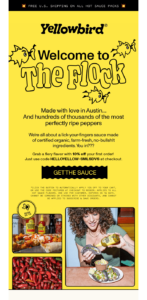
Yellowbird, a Texas-based hot sauce company, did a few things well in this excellent example of a welcome email. They include:
- Opening with an eye-catching graphic and a pun about joining “the flock.”
- Mentioning free shipping for hot sauce packs.
- A casual, informal tone that matches the brand.
- A discount code for the first order with a 14-day validity creates a sense of urgency.
- Links to product lines.
Additional resources:
Here are some extra resources to help you with your welcome campaigns:
Abandoned cart emails
We’ve all been there—you’re window shopping at an eCommerce store and adding items to your cart, but you leave without purchasing anything.
As over 88% of online orders are abandoned, using abandoned cart emails in your retail email marketing strategy will help you recover abandoned sale.
Here’s a great example of an abandoned cart email from Javy, a specialty coffee product retailer.
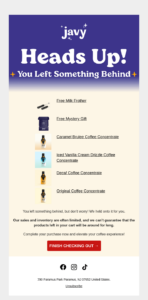
This abandoned cart email includes a few things we like:
- Short, eye-catching intro.
- Letting the customer know their basket is saved.
- Informing the reader that products are often limited and might not be available if they delay purchasing creates a sense of urgency.
- A bold call-to-action (CTA) directs the reader to complete the purchase.
Additional resources
Find our more about abandoned cart emails below:
- Brilliant Abandoned Cart Email Templates
- Smart Abandoned Cart Subject Lines To Boost Open Rates
- Best Abandoned Cart Emails To Not Lose Sales
Product recommendations
Are you launching new products? Do you have recommendations based on past purchases? If so, it’s time to add product recommendations to your email campaigns.
Product recommendation emails are a fantastic way to notify subscribers about products that match their buyer persona.
Email marketing platforms like Moosend offer product recommendations features to streamlines cross-selling, upselling, and recommendation campaigns. They also have AI functionality to tailor your product promotions based on past purchases.
Plus, Moosend offers a pre-made template library to help you during the creation process and save valuable time and effort.
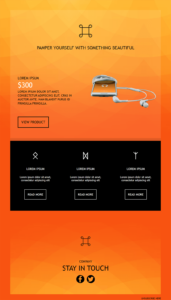
If you want to use this template to create your next big product recommendation email and send it to your audience, don’t forget to sign up for a Moosend account.
Promotional emails
The primary purpose of a promotional email is to promote a discounted product, service, or special offer to encourage your customers to make a purchase.
These emails can take different forms, from simply announcing the sale or enclosing a coupon to being tailored to a specific audience segment.
Here’s a great example for you email marketing for retail strategy.
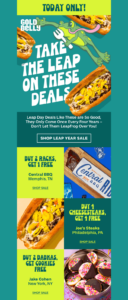
Goldbelly is an online food marketplace that allows customers to purchase food from restaurants.
In February, it ran a one-day-only Leap Year special and sent the above email to customers to promote it. Here’s what we like:
- Immediately creates a sense of urgency.
- Cute graphics that fit the sale’s theme, paired with leap day puns.
- A CTA close to the top of the email, straight after the opening graphics.
- Details about some offers from different restaurants alongside high-quality product photos.
Transactional messages
Transactional emails are automated emails triggered by a customer’s actions, such as order confirmations, shipping notifications, password resets, and purchase receipts.
Retailers can leverage transactional emails to keep customers informed and engaged throughout their purchase journey.
For instance, sending a detailed order confirmation immediately after a purchase reassures customers that their order has been received and is being processed.
Further reading: Learn more in our transactional campaigns guide.
You can automate and track transactional emails easily through an email platform, ensuring timely delivery and valuable insights for optimization.
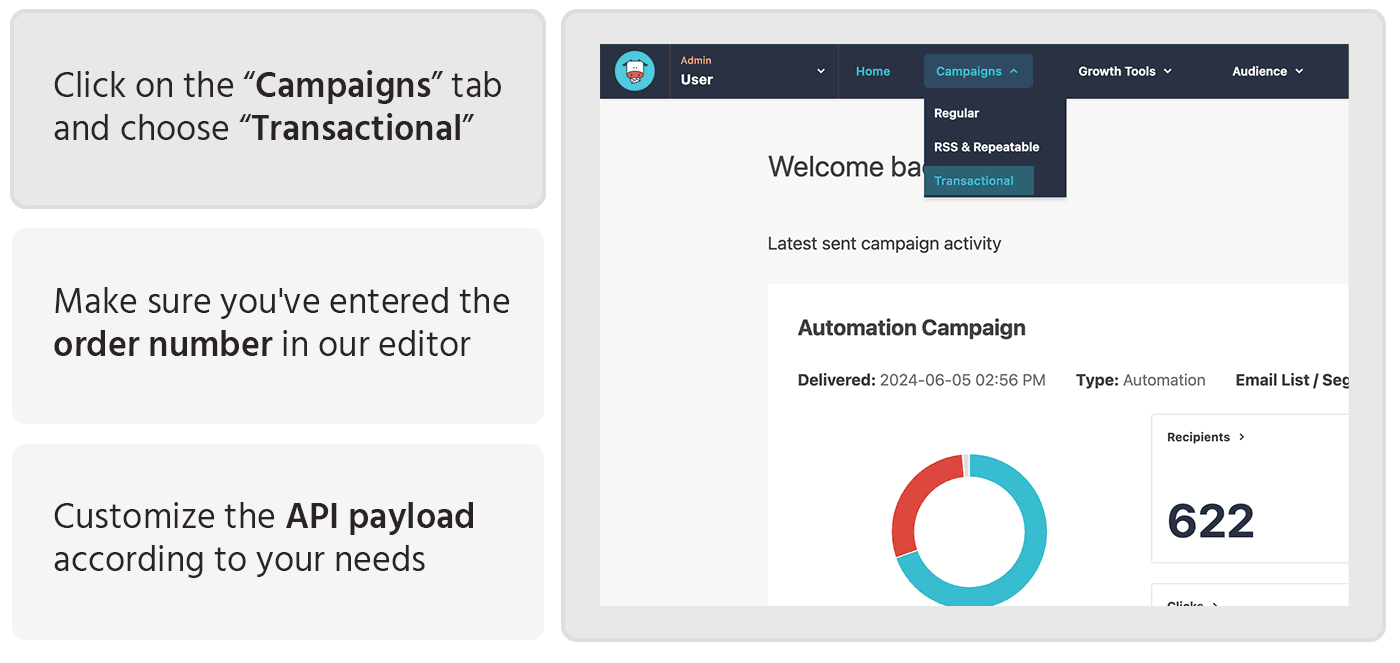
Moosend offers these features as part of its Moosend+ plan, allowing you to choose the add-ons you need to streamline your operations without breaking the bank.
Urgent emails
You might have noticed a common theme in the things we’ve liked about the previous email examples—they all create a sense of urgency. Our next retail email marketing campaign fits this theme well, as urgency is what it’s all about.
Different emails can be classed as urgency emails, including:
- One-day sales
- Restocks
- Last chance items
- Clearance
The email below from Rael, a Los Angeles-based period and self-care product company, promotes the end of its Labor Day sale.

This is an excellent example of an urgency email because:
- Right away, it lets the reader know the sale is ending.
- The promotion is shown in big text with a CTA directing the recipient to the shop.
- Some of Rael’s trending products are shown underneath, with their sale discount displayed alongside.
Competition and giveaway emails
While most competitions are hosted on social media today, promoting them with a giveaway email campaign allows you to link them to your other products or shop front simultaneously.
That’s what Getaway did with their Mother’s Day competition email, pictured below.
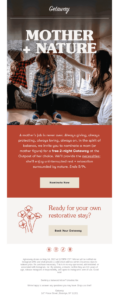
The brand owns several tiny cabins near major US cities and offered a free two-night stay at one of its cabins to the winner of its Mother’s Day competition. Entrants were asked to nominate a mom they thought deserved the break.
Here’s why we chose this email:
- A clever play on words at the beginning of the email.
- Earthy, natural colors fit the brand well and match the hero image.
- Highlighted text describing the prize.
- Contrasting CTA button.
- A second section with swapped colors and a CTA guides the reader to book their stay, tying the competition entry to a potential purchase.
Seasonal campaigns
Many retail businesses rotate stock during the changing seasons and bring out new items that fit the upcoming season. This is an ideal opportunity to reach out to your customers and inform them about your latest products with a seasonal email campaign.
Drifter Surf, a surfing lifestyle brand from Bali, did this for the launch of its summer products in the email below.
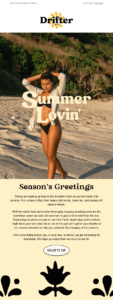
We like this summer email marketing campaign for a few reasons:
- A summery photo opens the email with a short summer-related text overlay.
- The intro text talks about summer in Bali to set the scene.
- Detailed explanations about new product lines paired with on-theme product photos.
- Short, punchy CTAs.
Further reading: If you want to incorporate seasonal campaigns in your retail email marketing strategy, here are some holiday email newsletter templates you can use.
Loyalty program emails
A loyalty program is an effective method of acquiring emails for your email list, growing a loyal customer base, and rewarding customers who make repeat purchases.
To keep your customers updated, consider including loyalty program emails in your campaign, like this one from Dr. Squatch.

This men’s personal care retailer specializes in all-natural products. Their loyalty program rewards customers with points for various activities. The points can be redeemed for discounts.
Here’s what we liked about this email:
- Points total with a “View Rewards” CTA at the top.
- A big, eye-catching trophy graphic makes the recipient feel like they’ve achieved something.
- Consistent CTAs lead to further information about the loyalty program.
- A section that explains the perks of the Squatch Man level with matching icons.
- Explanation of what points can be redeemed for.
- It visually explains the loyalty program and how customers can earn points.
Educational content
While this type of email campaign may only work for some retailers, sending educational content to your customers can be beneficial.
Educational content can cover various topics, depending on your market and niche. For example, if you sell skincare products, you could send educational content about the benefits of adding a retinol serum to your skincare routine.
Establishing your brand as an expert helps build trust and credibility and positions you as an authority. Customers who view you that way are more likely to purchase your products.
If you already have or planning to create a blog for your business, you can use email to send you audience blog highlights, tips, and more.
Here’s a great email newsletter template to get started.

Announcements and updates
Emails are an excellent way to get important information, like announcements and updates, to your customers. They serve a broad purpose, too, as they:
- Inform customers about new products or company updates.
- Build anticipation for upcoming events, sales, or product launches.
- Enhance communication with your subscribers and keep them in the loop, fostering trust and customer loyalty.
- Encourage engagement by directing them to visit your website, make a purchase, etc.
The following email from Toto Foods is a great example of retail email marketing done right.

Toto is a retailer that sells plant-based, gut-friendly cookies. Its email announcing where customers can find them has been executed well and has achieved all of the goals we mentioned above.
Here’s why:
- We’re immediately engaged with the opening text as it drives our curiosity.
- The colors and tone of voice are on-brand, bright, and engaging.
- The image fits the announcement while also driving up excitement.
- The text is concise while delivering all the required information.
- Two of the product images have “new” stickers next to them, building anticipation for customers to get the new product at a local store.
Customer feedback surveys
Collecting customer feedback is crucial for ensuring you’re meeting your customer’s needs, and sending feedback or survey requests in your emails is a good strategy for acquiring information.
As you aim for continuous improvement, insightful data about customer preferences, satisfaction levels, and areas to improve is hugely beneficial for making informed, data-driven decisions.
Feedback requests can be sent as standalone emails or triggered emails after an event, like the one below from Bellroy.
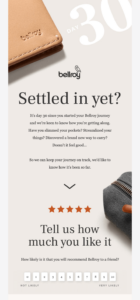
This Australian company produces sleek, environmentally friendly, minimalist wallets, bags, and accessories. It sent this email to a customer 30 days after they purchased a Bellroy item.
We love this email because:
- It asks questions relating to the results of buying the product.
- It’s a post-purchase follow-up email that ties in the request for feedback without being pushy or intrusive.
- The layout is sleek and minimal, just like Bellroy’s products.
- Customers can quickly leave feedback directly from the email.
Now that you know the emails you can include in your campaigns, let’s examine how to set up your email marketing strategy.
How to Build Your Retail Email Marketing Strategy
Building your email marketing strategy doesn’t have to be complicated. Here are the steps.
1. Determine specific goals
Setting SMART (specific, measurable, achievable, realistic, and time-bound) goals is a vital first step in any marketing strategy. Well-defined goals will help you keep your strategy on track and give you something to work toward.
Consider what you want to achieve by incorporating email campaigns into your marketing efforts. Do you want to drive sales, create a better customer experience, or boost retention with a loyalty program?
Whatever goal you choose, ensure you can see if you’re achieving it, ideally through crucial performance metrics. We’ll cover this in more detail later.
2. Choose the right email marketing platform
Choosing an email marketing platform that fits your needs is crucial to ensure your email campaigns are successful.
As a retailer, you should consider the following factors when choosing your email service provider:
- Ease of use
- Customizable templates
- Email automation capabilities
- Ecommerce platform integration (Shopify, WooCommerce, etc.)
- Thorough tracking and analytics
- Scalable pricing
- Additional lead generation tools (landing pages, forms)
- Excellent customer support (especially if you’re new to the game)
We realize that’s a lot to take in. So, if you want a great option to get started, Moosend has all those features and more at an affordable price. You can create, send, and automate email campaigns from one platform.
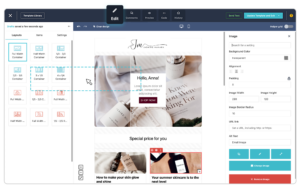
Plus, the software is ideal for beginners, offering a user-friendly editor, pre-made templates, and automation that’s powerful and easy to set up.
3. Build a quality email list
You can build an email list from a variety of sources, such as:
- Requiring customers to create an account at checkout.
- Including a subscription form on your website, such as a pop-up or inline form.
- Offer in-store customers email receipts.
- Run email-only promotions.
- Create a loyalty program where loyal customers receive perks in their inboxes.
- Ask customers to sign up for your newsletter.
These are just a few of the options available to you. If you want to learn more, read our post on how to build an email list from scratch.
4. Create compelling designs and visuals
Next, it’s time to define your content strategy and start creating beautiful, personalized email content and visuals.
Say you want to send an email to all of your subscribers about an upcoming promotion. You want to ensure your visuals are eye-catching and the content is to the point but doesn’t leave any information out.
You could hire a designer specializing in email formats, but that will cost you.
Instead, consider using email templates. Here’s why:
- Consistent: Using a template ensures your branding and messaging stay consistent across all emails.
- Efficienct: Templates save time because your layouts are pre-designed, and you can quickly customize them to fit your needs.
- Professional: An impressive template will help you create professional-looking, polished email content, and that’s a big win for your brand reputation.
- Engaging: A common thread in the examples we gave above is that they captured and held our attention. Using a well-designed template can help you achieve this, too, and will boost your reader engagement.
- Scalable: As your business grows, you’ll need to scale your marketing strategies, and using templates from the outset is a great way to achieve this for your email campaigns, as you can easily replicate and adapt them to suit your needs.
5. Segment your audience and personalize your emails
Your email list is getting bigger by the day, thanks to the strategies you put in place for email capturing, but you don’t want to send all your email campaigns to everyone on the list.
That’s where email segmentation comes in. Here are a few methods you can use to group your audience:
- Demographic: Segment based on age, gender, income, education, etc.
- Geographic: Target customers by location, such as city, state, or country.
- Behavioral: Group customers based on their behavior, such as purchase history, website activity, or email engagement.
- Psychographic: Segment based on lifestyle, values, interests, or personality traits.
- Engagement: Group customers by their level of interaction with your emails, like active vs. inactive subscribers.
- Lifecycle stage: Target customers at different stages of the buying cycle, such as new subscribers, repeat or lapsed customers.
Once your audience segments are down, you can send more personalized content, such as product recommendations based on previous purchases.
Further reading: New to segmentation? Learn all about segments in our comprehensive email segmentation guide (examples included).
6. Establish a consistent sending schedule
Consistency is vital in email marketing. Your customers’ attention will fade if you don’t send emails out regularly. Send too many emails, though, and you ask them to unsubscribe.
Figuring out the best consistency for your audience can take time and effort. An excellent place to start is by evaluating industry norms and your customer’s preferences, which you can establish through A/B testing.
Once you’ve established the ideal sending cadence, create an email marketing calendar that houses your content. Then, you can use your email service provider’s automation features to deliver your emails at the chosen intervals.
Lastly, don’t forget to find the best time to deliver your emails as this will give you great open rates and click-throughs.
According to Moosend’s best time to send an email analysis, the most ideal time is between 8 and 9 am.
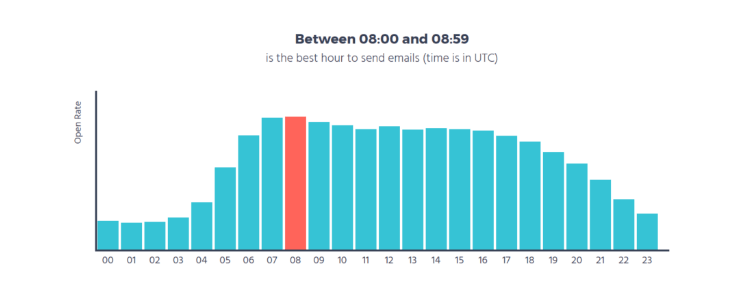
7. Track, analyze, and optimize
It’s vital to continually improve your marketing strategies as markets and industries fluctuate and change.
In step one, we mentioned tracking key performance metrics for your goals. This will help you benchmark your campaigns and understand whether they perform as intended.
Additionally, using A/B testing can further optimize your email marketing efforts. A/B testing, also known as split testing, involves creating two versions of an email to test different variables such as subject lines, email content, or call-to-action buttons.
By sending these variations to different segments of your audience, you can analyze which version performs better in terms of open rates, click-through rates, and conversions. This approach allows you to make informed decisions and continuously refine your campaigns for better results.
Retail Email Marketing Tips & Best Practices
You may be eager to start retail email campaigns but don’t rush off yet. First, check this list of tips and best practices to help you maximize the likelihood of success.
- Email design and layout: Make sure your emails look good on mobile devices, are consistent, and align with your brand aesthetic. Include whitespace for readability, alt-text for inclusivity, and clear CTAs.
- Optimize your subject lines: Convey value or urgency to entice the recipient to open the email. Be concise and attention-grabbing, but avoid spam words like “buy now,” “win,” or “save.”
- Personalize the content: Address the recipient by name and tailor the content to their preferences, purchase history, or browsing behavior to make it more relevant, and you’ll likely see a boost in engagement.
- Segmentation: Use customer information to segment your lists so you can send more relevant content to your audience.
- Email list hygiene: Regularly clean your email lists, too, so you don’t waste resources sending emails to inactive or unengaged subscribers.
- Timing and frequency: Too many emails will overwhelm your subscribers, and odd sending hours will result in missed emails. Establish the best time and frequency (e.g., weekly, bi-weekly, or monthly) and stick to it.
- A/B testing: Try out different subject lines, CTAs, and layouts until you find what best suits your audience, then use the results to inform your strategy going forward.
- Compliance with regulations: Regulations like GDPR govern email marketing, and you need to adhere to them, or you could face legal problems and fines.
Don’t forget to obtain consent from your subscribers through opt-in methods, provide opt-out (unsubscribe) options, and disclose any required information in your emails.
Further reading: Discover more on our list of email marketing best practices that drive results.
How to Measure the Success of a Retail Email Marketing Campaign
There are several key email metrics and performance indicators that you can use to measure how successful your retail email campaigns are.
- Open rates: What percentage of recipients opened the email? A high open rate indicates good subject lines and high relevance to the recipient.
- Click-through rates (CTR): How many recipients clicked on links in the email? Which links did they click? A high CTR indicates engaging content and compelling CTAs.
- Conversion rate: How many recipients completed the actions you wanted them to perform, like making a purchase? High conversion rates show your messaging and offers work.
- Generated revenue: Tracking the revenue attributed to specific email campaigns compared to the cost involved gives you a direct measure of ROI.
- Engagement metrics: Monitor metrics like time spent reading emails and how often they were forwarded elsewhere. That gives you an idea of how deeply people engage with your content.
- Subscriber growth: Is your email list growing? Good! Measure how fast it’s growing and which channels contribute the most to understand the effectiveness of your acquisition strategies.
To interpret these metrics, analyze the trends over time, segment the data, and compare the performance against benchmarks (like industry standards).
If you want to enhance those metrics, improve what they relate to. For example, write more compelling subject lines to increase open rate, increase CTR with relevant content and CTAs, and foster more profound engagement with personalized content.
Regularly testing your strategies and adapting them to fit your goals are essential for improvement. Remember, just because your strategy works now doesn’t mean it’ll still work six months from now or that it couldn’t perform better.
Start Creating Your Next Email Marketing Campaign
Email marketing campaigns are highly effective and beneficial for retailers who wish to boost their revenue, drive sales, and create a loyal customer base.
Using an email service provider (ESP) can simplify the process and enhance your campaigns. With features like beautiful email templates, marketing automation, and advanced segmentation, an ESP allows you to efficiently manage and optimize your email marketing efforts. These tools help ensure your emails are personalized and relevant, improving engagement and conversion rates.
You can try Moosend for free to see how an ESP can streamline your email marketing campaigns and help you achieve your marketing goals.
Frequently Asked Questions (FAQs)
You might still have questions about retail email marketing but don’t worry. These FAQs provide the answers.
1. What makes a retail email subject line effective?
There are a few elements that make email subject lines effective, including:
- Relevance to the recipient
- Brevity, while providing enough information
- Creating a sense of urgency or curiosity
- Offering a benefit, like a discount or early access to new products
- Personalization
An eCommerce AI tool can help you craft compelling, personalized subject lines quickly and easily. To learn more, read our article on subject line best practices.
2. How can retailers use automation in their email marketing strategy?
In retail email marketing, automation can send customers personalized messages based on various factors, like past purchases or browsing history. This includes cart abandonment emails, product launches and recommendations, and birthday emails.
Streamlining your email workflows with an automation tool like Moosend can help you deliver timely and relevant emails to your customers.
3. What are the best practices for segmenting a retail email list?
Segmenting your retail email list is essential for targeting the right audience effectively. Consider demographics like age and gender to tailor content, and use psychographics to match lifestyle and interests. Track engagement levels to identify your most and least engaged email subscribers, and segment by purchase history for targeted promotions.
Finally, use browsing history to send personalized product recommendations. These practices ensure relevant and impactful email campaigns, boosting engagement and conversions.




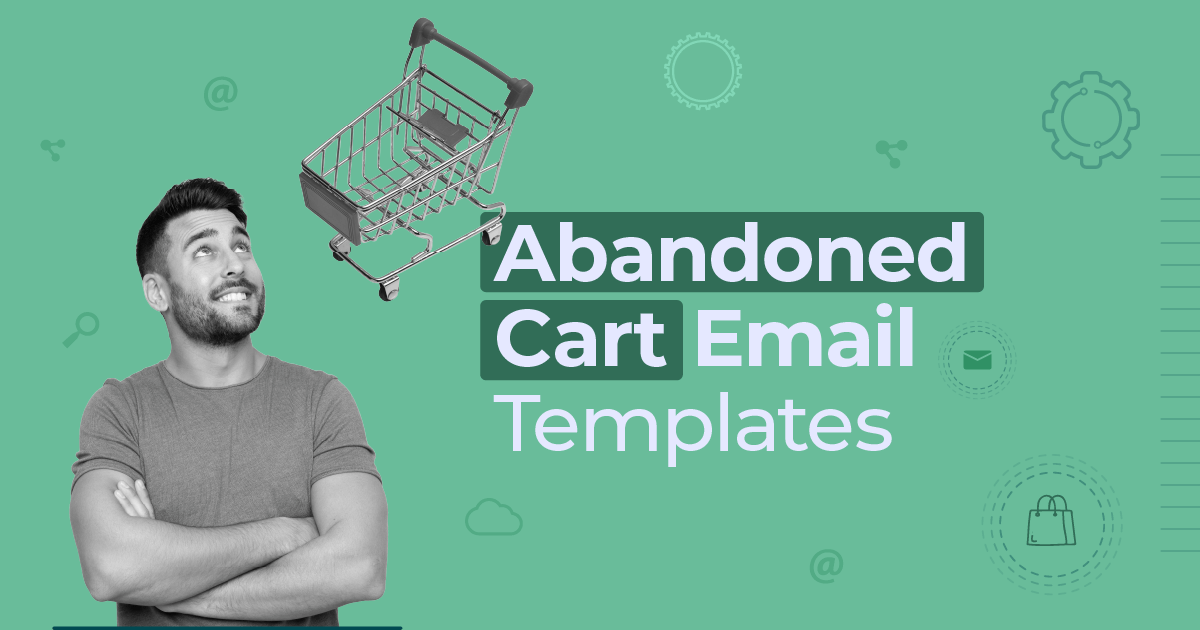
 Published by
Published by
